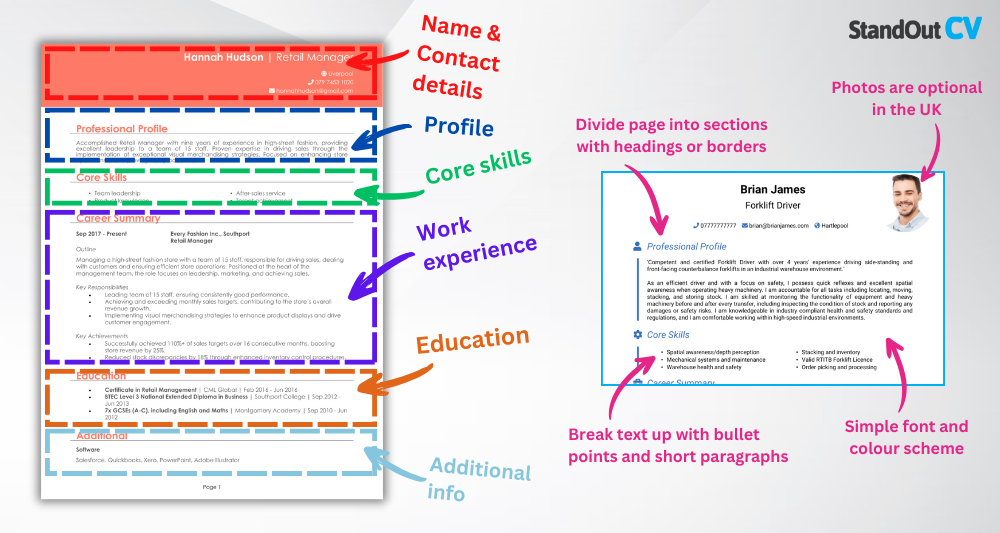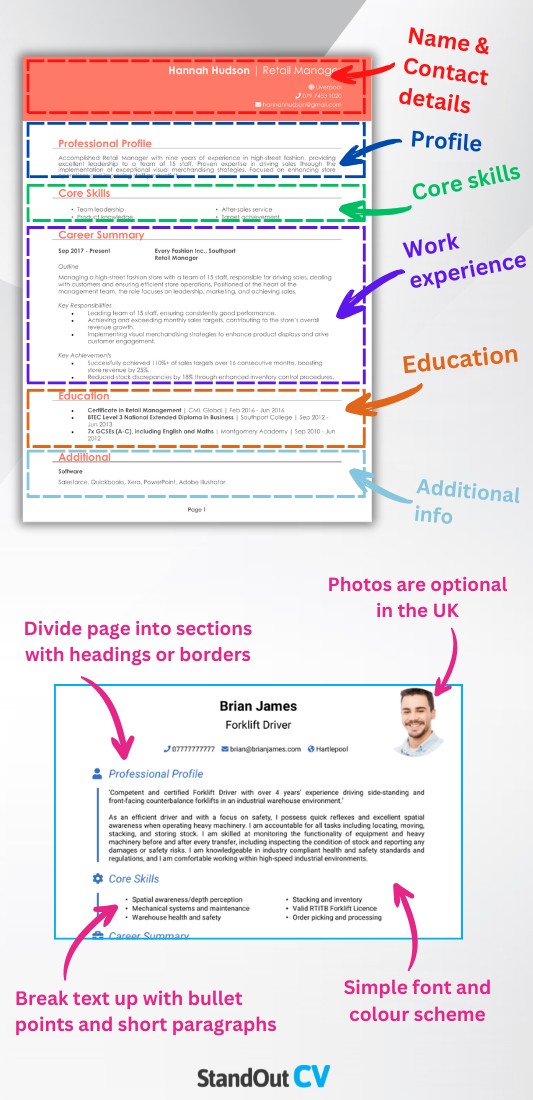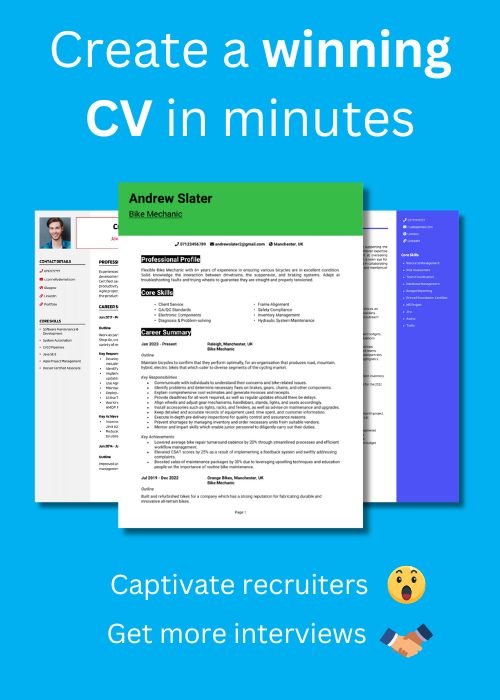Your work uncovers the microscopic details that can have a massive impact. A CV for a microbiologist should have the same precision as your lab reports: clear, organised, and able to highlight the findings (your value) at a glance.
This guide and its Microbiologist CV example will take you through how to write an application that communicates your expertise and professional value in a way that convinces hiring managers you’re the right fit.
Microbiologist CV sample

How to write your Microbiologist CV
Discover how to craft a winning Microbiologist CV that lands interviews with this simple step-by-step guide.
Scientific skills alone unfortunately aren’t enough to secure a new role – how you present them matters just as much. A well-structured, carefully tailored CV can help you stand out from equally qualified peers and make an immediate impact with recruiters.
In the sections below, you’ll find guidance on structuring and writing a CV, selecting the right information to include, and framing your background so it resonates with employers in your field.
How should you structure and format a Microbiologist CV?


Just as experiments follow a logical methodology, your CV should follow a clear and accessible structure. Recruiters and hiring managers will quickly dismiss a document that feels disorganised, even if the skills are there. Present your career in a way that allows them to locate the most relevant details with ease.
Here’s the structure to follow:
- Name and contact details – Display your personal details clearly at the top so employers can get in touch easily. Including a photo is entirely optional.
- Profile – Begin with a concise summary that highlights your expertise and what you bring to the role.
- Core skills – Highlight your strongest skills that align with the role’s requirements.
- Work experience – Start with your most recent role and work backwards, showcasing achievements and responsibilities.
- Education – Mention your degrees, certifications, and any training that supports your career path.
- Additional info – Include any additional details, like awards, professional memberships, or hobbies that highlight your skills or personality.
When it comes to presentation and layout, aim for a format that is as professional as it is easy to read. Use bullet points to break down text, separate sections with clear headings, and maintain a clean, readable font. Keep the CV length within two pages, but make good use of white space so your skills and achievements have room to stand out.
Writing a Microbiologist CV profile


Think of your CV profile as your abstract – the concise summary that encourages someone to read further. It should capture your most relevant experience and the value you bring to an employer, whether that’s advancing research or ensuring compliance. This is your chance to set the tone for the rest of your CV by making clear what you can contribute.
Microbiologist CV profile examples
Profile 1
Experienced Microbiologist with over 15 years in clinical and industrial laboratories, specialising in microbiological testing, pathogen detection, and quality assurance. Skilled in designing and executing experiments, validating laboratory methods, and maintaining compliance with GLP and ISO standards. Proficient in PCR, ELISA, and LIMS systems. Recognised for delivering accurate results under strict deadlines and supporting cross-functional teams in research and diagnostics.
Profile 2
Skilled Microbiologist with eight years of experience in food safety and pharmaceutical microbiology. Conducted microbial analysis, environmental monitoring, and sterility testing to ensure regulatory compliance. Adept at using microbiology techniques including culture, microscopy, and antimicrobial testing. Experienced in GMP environments and reporting findings to regulatory bodies. Known for strong analytical skills and attention to detail.
Profile 3
Motivated Microbiologist with three years of experience in academic research and teaching laboratories. Supported projects on antimicrobial resistance and microbial genetics while mentoring undergraduate students. Comfortable using bioinformatics tools, data analysis software, and maintaining accurate laboratory records. Passionate about advancing microbiological knowledge and contributing to scientific discovery.
Details to put in your Microbiologist CV profile
Here’s what to include in your profile:
- Where you worked – Outline the settings in which you’ve gained experience, such as academic research institutions, commercial laboratories, or healthcare facilities.
- Your top qualifications – Mention your most relevant degrees, accreditations, or certifications in microbiology or related disciplines.
- Essential skills – Summarise your key professional abilities in a way that aligns directly with the role requirements.
- Specialist areas or focus – Highlight any subfields or technical methods you’ve worked with extensively, such as environmental microbiology, molecular diagnostics, or antimicrobial resistance studies.
- Value delivered – Explain how your work has supported scientific goals, regulatory compliance, or operational efficiency.
Writing an effective core skills section


The core CV skills section gives recruiters a rapid overview of your capabilities. In highly competitive scientific roles, this can be the deciding factor in whether they keep reading.
Concentrate on tangible, measurable skills that are relevant to the specific microbiology role you’re targeting. Adapt these to match the job description and employer focus – the closer the alignment, the stronger your application will appear.
The top skills to highlight in your Microbiologist CV
- Microbial Culture and Isolation Techniques – Growing and isolating microorganisms from various samples using sterile laboratory methods.
- Microscopy and Staining Procedures – Identifying microbial species through techniques such as Gram staining and phase-contrast microscopy.
- Antimicrobial Susceptibility Testing – Determining resistance profiles of bacteria and fungi to guide treatment or product development.
- Molecular Biology Methods – Applying PCR, gel electrophoresis, and DNA extraction to analyse microbial genomes and detect pathogens.
- Sterility and Contamination Control – Maintaining aseptic conditions in laboratory and production environments to ensure sample integrity.
- Environmental Monitoring and Sampling – Collecting and analysing air, water, and surface samples to detect microbial contamination.
- Data Recording and Laboratory Reporting – Documenting experimental results accurately and compiling technical reports for research or regulatory use.
- Biosafety and Laboratory Compliance – Following safety protocols and regulatory standards for handling biohazardous materials.
- Microbiological Quality Control – Testing raw materials, finished products, or pharmaceuticals to ensure compliance with safety standards.
- Research and Development Support – Contributing to scientific studies or product development by investigating microbial behaviour and interactions.
Showcasing your work experience


Your work experience section demonstrates how you’ve applied your expertise in practical settings. Employers will want to see how you’ve contributed to research objectives, improved processes, or supported regulatory and quality requirements.
Present your roles in reverse chronological order, starting with the most recent. For each, provide a short summary of the position and the organisation before detailing responsibilities and achievements in bullet points. Make sure your examples highlight both technical competence and the impact of your work.
Writing job descriptions for past roles

- Outline – Introduce the organisation, your role, and the purpose of your position, noting who you reported to and the type of projects or work undertaken.
- Responsibilities – Describe your main duties, using action words like “analysed” and “developed.” For example: “analysed bacterial cultures for contamination risk” or “developed testing protocols for quality assurance.”
- Achievements – Provide measurable achievements, such as reduced processing time, successful regulatory audits, or contributions to published research.
How to present past roles for Microbiologists
Microbiologist | Harrington Clinical Laboratories
Outline
Worked in a large clinical diagnostics laboratory processing patient samples for bacterial, viral, and fungal pathogens. Ensured accurate and timely results to support medical decision-making in hospitals and healthcare settings.
Responsibilities
- Performed culture, isolation, and identification of clinical microorganisms
- Conducted antimicrobial susceptibility testing in line with CLSI standards
- Maintained LIMS records for traceability and reporting
- Prepared and reviewed standard operating procedures for laboratory processes
- Collaborated with medical staff to interpret results and advise on treatment options
Achievements
- Reduced turnaround times for urgent tests by 20% through workflow improvements
- Contributed to outbreak investigations that supported infection control teams
- Maintained zero critical errors across two consecutive laboratory audits
Microbiologist | Greenvale Pharma Solutions
Outline
Provided microbiological support for a pharmaceutical manufacturing company producing sterile medicines. Focused on quality control, environmental monitoring, and regulatory compliance.
Responsibilities
- Conducted sterility testing of finished products and raw materials
- Performed environmental monitoring of cleanrooms and production facilities
- Tested water and air samples for microbial contamination
- Documented results in accordance with GMP and regulatory requirements
- Participated in root cause analysis during deviations and contamination events
Achievements
- Helped maintain 100% GMP compliance across three consecutive MHRA inspections
- Reduced environmental contamination rates by 15% through revised cleaning protocols
- Supported successful validation of two new production lines
Microbiologist | Westbridge University Research Centre
Outline
Conducted microbiological research within an academic laboratory focusing on antimicrobial resistance. Supported senior researchers while contributing to publications and laboratory teaching activities.
Responsibilities
- Carried out experiments on microbial genetics and resistance mechanisms
- Prepared and maintained microbial cultures for ongoing research projects
- Used PCR and sequencing techniques to identify genetic mutations
- Mentored undergraduate students during practical classes and laboratory sessions
- Maintained accurate laboratory notebooks and contributed to grant reporting
Achievements
- Published findings in a peer-reviewed microbiology journal as co-author
- Improved DNA extraction efficiency by 25% through protocol optimisation
- Contributed to a successful grant application worth £150,000 in research funding
Highlighting your education


In a field as technical as microbiology, qualifications play a major role in demonstrating your credibility. Include your degree(s) and any postgraduate or specialist training, as well as industry-recognised certifications.
List your education in reverse chronological order, beginning with the most recent. If you’ve undertaken significant research projects, dissertations, or further training relevant to the role, include brief details to show depth of expertise and continuous professional development.
The best qualifications to boost a Microbiologist CV
- BSc (Hons) in Microbiology – Establishes fundamental scientific knowledge and lab skills.
- MSc in Microbiology or related field – Demonstrates advanced expertise and specialisation.
- PhD in Microbiology – Indicates research excellence and the ability to lead projects.
- Good Laboratory Practice (GLP) Certification – Confirms adherence to industry-standard protocols.
- Health and Safety in the Laboratory Certificate – Shows understanding of safety requirements in laboratory environments.





